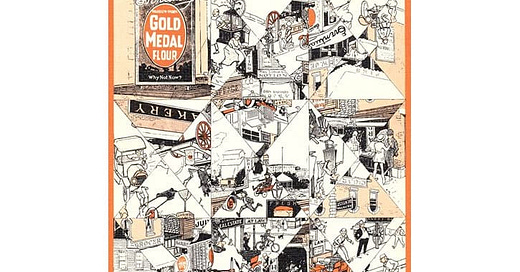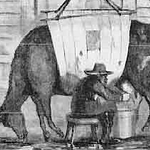You may never look at that bag of all purpose or cake flour the same after Kim and Leigh share the impacts of America's milling industry giants
In our second What’s in Your Pantry episode, a box of cake flour in Kim’s pantry led to a tasty Orange-Raisin Cake, but also the discovery of the tangled history of flour and flour milling. In this episode, Leigh and Kim look deeper into the impact of two American grain empires - the Pillsbury and General Mills - and we meet a very familiar icon: Betty Crocker.
Wheat Growing in the United States
Wheat wasn't an actively grown crop in the United States until the early 17th century, and the first American wheats were planted north and west of Washington DC, and traveled West to create the “Wheat Belt,” a 1500-mile-long stretch of Plains and Prairie lands running North to South from Central Alberta in the North to Central Texas.
Changes in milling technology introduced by Pillsbury and General Mills caused a shift in wheat farming between 1820 - 1880. Softer wheats grown in Kansas, Oklahoma, Texas, Nebraska, and Colorado gave way to harder wheats grown in Minnesota, North and South Dakota and Montana that were easier to process in steel roller mills. Approximately 60 percent of the wheat grown in the United States today is hard winter and spring red wheat.
Meet Pillsbury
1865 is the same year that saw the end of the American Civil War and the founding of CA Pillsbury and Company in Minneapolis, Minnesota by Charles Allen Pillsbury and his uncle.
The Pillsbury Company was also instrumental in forming the Millers Association through which agricultural agents inspected and bought grain. Pillsbury Co. also developed and implemented a system of grain elevators for storage and shipment, and it contributed heavily into railroad development, allowing products to be more easily shipped coast to coast, and ultimately shipped across the world.
Meet General Mills
Pillsbury was in direct competition, literally across the St. Anthony Falls, with the Washburn Crosby Company run by businessman and Union Army Major General Cadwallader Colden Washburn based on the holdings of the Minneapolis Mill Company, a general mill company originally chartered by the Minnesota Territorial Legislation in 1856.
General Washburn was joined by John Crosby in 1877 to form the Washburn Crosby Company, and in 1880, the company won gold, silver, and bronze medals for its flours at the Miller's International Exhibition. The success officially launched the Gold Medal Flour brand. The company eventually merged with other milling enterprises to form General Mills in 1928.
Meet Betty Crocker
Born from the most successful food brand campaign that has ever been rolled out in the United States was the ultimate culinary confidante, Betty Crocker - a woman who always had sound advice for baking and cooking and most domestic issues.
Consumers fell in love with her. She was practical. She was gracious. She was prompt and she was discreet. She became a trusted friend, someone who could be relied on to keep these culinary confessions and deficiencies private. Her impact outweighed her ability to sell a bag of flour.
And truly her lasting legacy is that Betty Crocker via her books, newsletters, or website has taught many people how to plan and cook a good meal. No wonder Fortune Magazine celebrated her as America’s First Lady of Food in a 1945 issue.
The Final Untangle
In 2001, General Mills finally acquired and merged with Pillsbury; inheriting all its holdings except for Burger King. Both firms contributed heavily to intercontinental railroads and the development of Minneapolis. Their joint holdings – including food products and restaurants – are massive.
At the end of the day, we feel that it is worth knowing the history of those business, large or small, that have a large share of our pantries or who create an icon who adds value to our lives. This is just a non-partisan example of the “American Dream” – real people who took opportunities and put big ideas into the world.
Grain Empire Transcript
🎧 Click here for the full, interactive transcript of this episode 🎧
Sources We Found Helpful for this Episode
Books We Think You’ll Enjoy Reading
Smart Cookies: How Home Cooks Became Finalists in the Pillsbury Bake-Off® Contest by Mary Beth Protomastro
Mill City: A Visual History of the Minneapolis Mill District - Minnesota Historical Society Press
Betty Crocker’s Best 100: Favorite Recipes from America's Most Trusted Cook (100th Anniversary)
Recipes You Really Need to Try
Snickerdoodle Cookies - Gold Medal Flour
Ultimate Chocolate Chip Cookie - Betty Crocker
Episodes We Think You’ll Like
Passover: Deliverance, Bitter Herbs, and Maxwell House Coffee
The Glorious Egg: Symbolism, Tiny Dinosaurs, and Egg Espionage
We would love to connect with you
AsWeEat.com, on Instagram @asweeat, join our new As We Eat community on Facebook, or subscribe to the As We Eat Journal.
Do you have a great idea 💡 for a show topic, a recipe 🥘 that you want to share, or just say “hi”👋🏻? Send us an email at connect@asweeat.com
Review As We Eat on Podchaser or Apple Podcast. We would like to know what you think.
And please subscribe to As We Eat, Going Places. Eric and Leigh will be traveling in their converted van sharing stories of food culture from the road.
If you are enjoying the podcast, we would love to have you join our patrons. For just a few dollars, you can get access to this exclusive content as well as more in-depth articles and help keep our oven lights on!
Thank you for listening to the As We Eat Podcast. This post is public so share it with a friend - or three :)

























Share this post